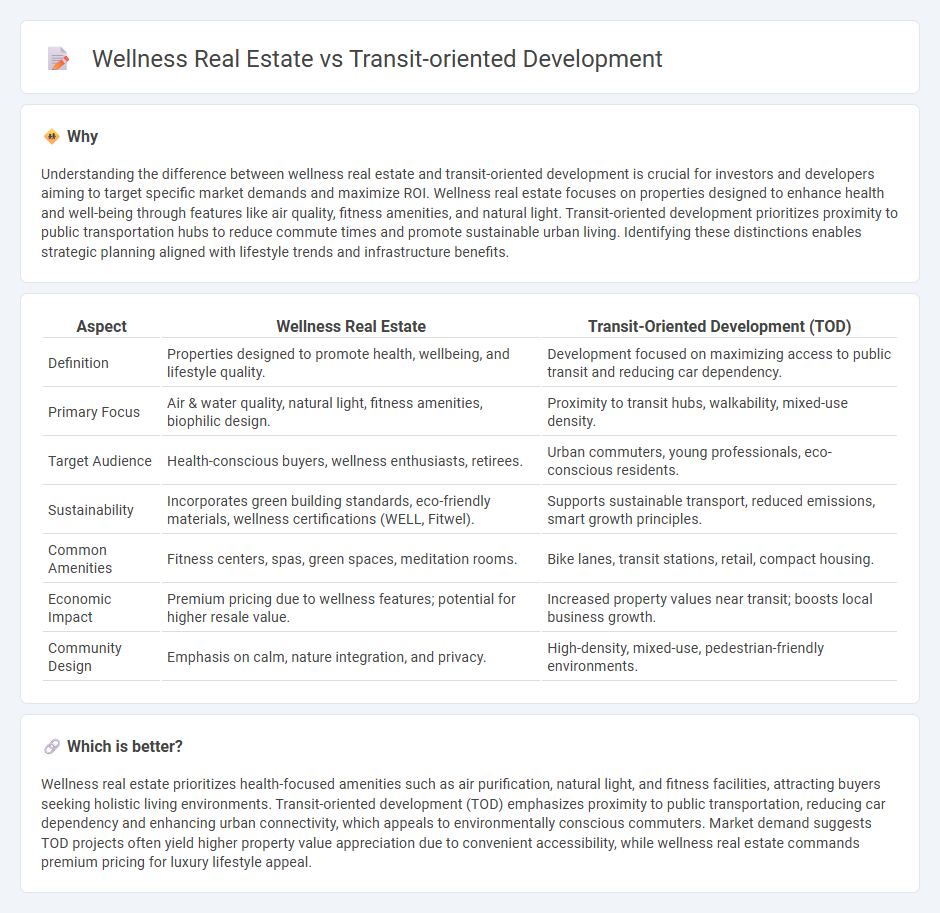
Wellness real estate focuses on properties designed to enhance health and well-being through features like natural lighting, air quality, and fitness amenities, promoting a holistic lifestyle. Transit-oriented development (TOD) prioritizes accessibility by integrating residential and commercial spaces within walking distance of public transportation hubs, reducing reliance on cars and encouraging sustainable urban growth. Explore the unique benefits and investment opportunities of these real estate trends to make informed decisions.
Why it is important
Understanding the difference between wellness real estate and transit-oriented development is crucial for investors and developers aiming to target specific market demands and maximize ROI. Wellness real estate focuses on properties designed to enhance health and well-being through features like air quality, fitness amenities, and natural light. Transit-oriented development prioritizes proximity to public transportation hubs to reduce commute times and promote sustainable urban living. Identifying these distinctions enables strategic planning aligned with lifestyle trends and infrastructure benefits.
Comparison Table
| Aspect | Wellness Real Estate | Transit-Oriented Development (TOD) |
|---|---|---|
| Definition | Properties designed to promote health, wellbeing, and lifestyle quality. | Development focused on maximizing access to public transit and reducing car dependency. |
| Primary Focus | Air & water quality, natural light, fitness amenities, biophilic design. | Proximity to transit hubs, walkability, mixed-use density. |
| Target Audience | Health-conscious buyers, wellness enthusiasts, retirees. | Urban commuters, young professionals, eco-conscious residents. |
| Sustainability | Incorporates green building standards, eco-friendly materials, wellness certifications (WELL, Fitwel). | Supports sustainable transport, reduced emissions, smart growth principles. |
| Common Amenities | Fitness centers, spas, green spaces, meditation rooms. | Bike lanes, transit stations, retail, compact housing. |
| Economic Impact | Premium pricing due to wellness features; potential for higher resale value. | Increased property values near transit; boosts local business growth. |
| Community Design | Emphasis on calm, nature integration, and privacy. | High-density, mixed-use, pedestrian-friendly environments. |
Which is better?
Wellness real estate prioritizes health-focused amenities such as air purification, natural light, and fitness facilities, attracting buyers seeking holistic living environments. Transit-oriented development (TOD) emphasizes proximity to public transportation, reducing car dependency and enhancing urban connectivity, which appeals to environmentally conscious commuters. Market demand suggests TOD projects often yield higher property value appreciation due to convenient accessibility, while wellness real estate commands premium pricing for luxury lifestyle appeal.
Connection
Wellness real estate prioritizes health-focused design, incorporating green spaces, natural light, and air quality, which enhances residents' well-being and aligns with the principles of transit-oriented development (TOD) that promotes walkability and access to public transit. Transit-oriented development reduces reliance on cars, encourages active transportation such as walking and cycling, and supports a healthier lifestyle, directly complementing wellness real estate goals. Combining wellness real estate with TOD creates sustainable urban environments that foster both physical health and environmental benefits.
Key Terms
Transit-oriented development:
Transit-oriented development (TOD) emphasizes creating walkable, mixed-use communities centered around high-quality public transportation hubs, enhancing accessibility and reducing reliance on cars. This approach promotes sustainable urban growth, increases property values, and supports local economies by integrating residential, commercial, and recreational spaces. Explore more about how TOD transforms urban living and drives sustainable city planning.
Mixed-use zoning
Transit-oriented development (TOD) leverages mixed-use zoning to integrate residential, commercial, and recreational spaces around public transit hubs, promoting walkability and reducing car dependency. Wellness real estate incorporates mixed-use zoning by combining living spaces with health-focused amenities such as fitness centers, green spaces, and wellness clinics to support residents' holistic well-being. Discover how blending TOD and wellness real estate through mixed-use zoning can reshape urban living for sustainability and health benefits.
Walkability
Transit-oriented development prioritizes high-density, mixed-use neighborhoods designed around public transit hubs, enhancing walkability by reducing car dependency and connecting residents to jobs, shops, and services within a short distance. Wellness real estate emphasizes health-promoting features like green spaces, pedestrian-friendly pathways, and air quality, creating environments that encourage walking as a form of exercise and mental well-being. Explore the impact of walkability on urban living and property value in both sectors for deeper insights.
Source and External Links
Transforming the Urban Space Through Transit-Oriented Development - This webpage describes Transit-Oriented Development (TOD) as a strategy to concentrate jobs, housing, and services around public transport stations, promoting compact, mixed-use, and pedestrian-friendly urban environments.
Transit-Oriented Development - TOD Standard - This webpage explains TOD as an approach to urban development that integrates land use and transport services, fostering compact city growth and reducing dependency on motor vehicles while improving lifestyles and resource efficiency.
Transit-Oriented Development | FTA - This page discusses how Transit-Oriented Development (TOD) combines dense, walkable, mixed-use development near transit to create vibrant communities, attract people, and support partnerships for affordable housing and economic growth.
 dowidth.com
dowidth.com